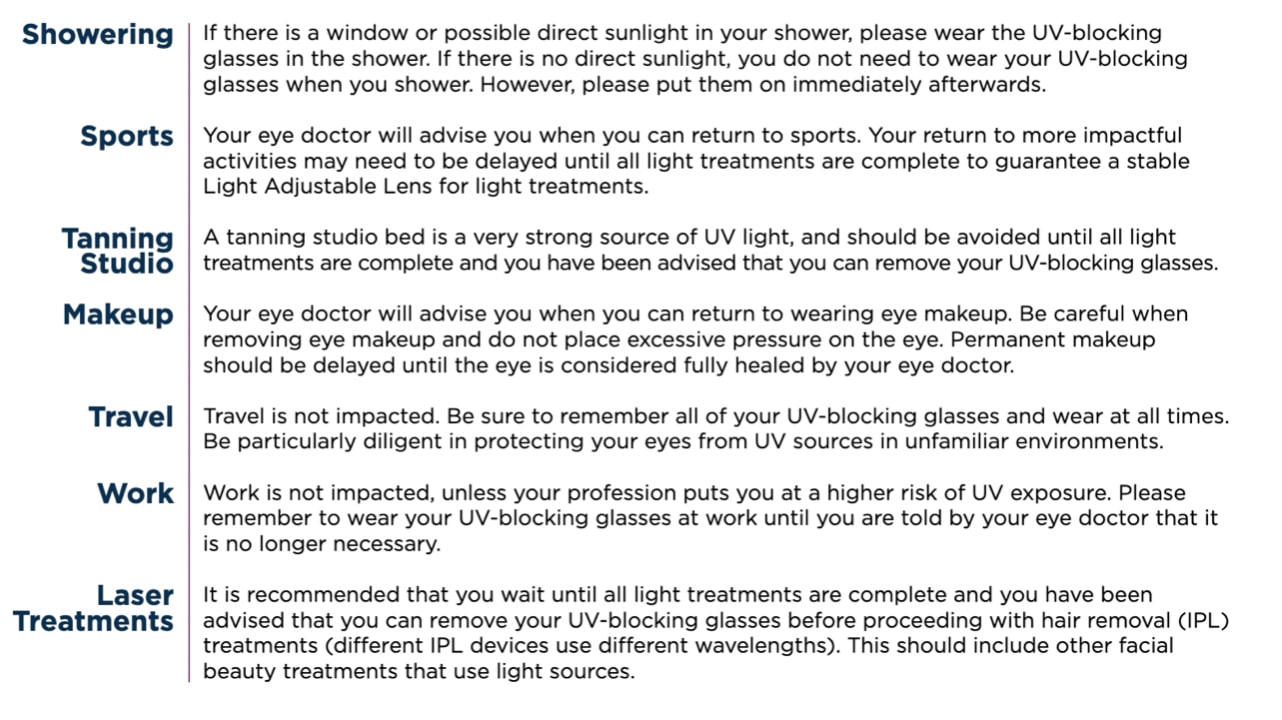Light Adjustable Lens Experience
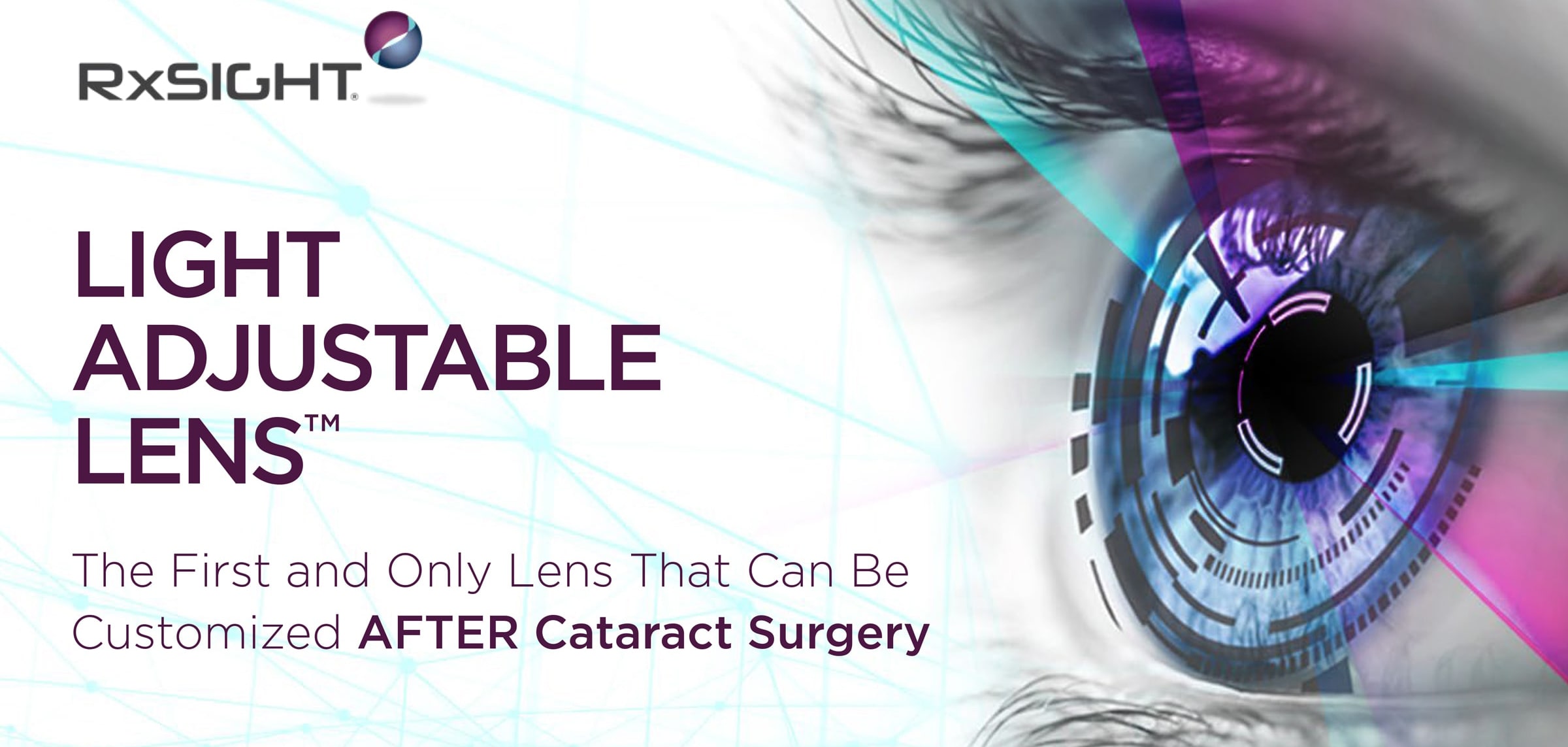
Selecting a Lens Implant (IOL) for Cataract or Refractive Lens Exchange Surgery
Dr. Hamilton uses pre-surgery eye measurements and intraoperative diagnostic tools at his office in Beverly Hills, Los Angeles to estimate the power and type of IOL he thinks will provide you with the best vision after surgery.
Every eye of every patient heals in its own, unique way. This healing process can affect the position of the IOL in the eye. If the IOL heals into place more towards the front of the eye than average, the eye ends up slightly nearsighted. Similarly, if the IOL heals into place more towards the back of the eye than average, the eye ends up slightly farsighted.
Despite the number and quality of measurements used to select the IOL power and predict the visual outcome, it is still just an estimate for any given patient. And because every eye heals slightly differently after surgery, getting ‘close’ to the predicted outcome is often the best result a patient can expect. If the visual target is not achieved, this can be corrected by glasses, contact lenses, or additional surgery, such as LASIK or by removing and replacing the IOL.
How are Cataracts Treated?
The only treatment for cataracts is to remove the cloudy natural lens and replace it with a clear artificial lens. This lens is called an intraocular lens (IOL). Cataract removal surgery is the most common procedure in the world and is one of the safest and most successful procedures performed today.
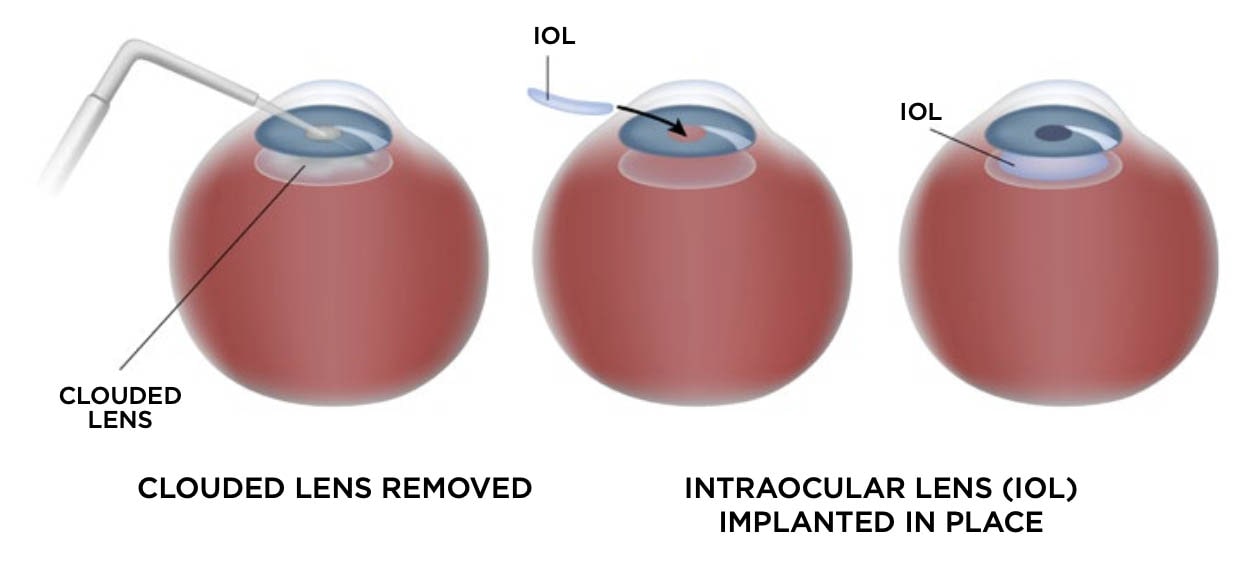 Cataract surgery can also offer the opportunity to correct other visual problems you may experience such as myopia (nearsightedness), hyperopia (farsightedness), astigmatism (irregularly shaped lens), or presbyopia (diminishing ability to focus with age.
Cataract surgery can also offer the opportunity to correct other visual problems you may experience such as myopia (nearsightedness), hyperopia (farsightedness), astigmatism (irregularly shaped lens), or presbyopia (diminishing ability to focus with age.
Light Adjusting Lens Implant Option
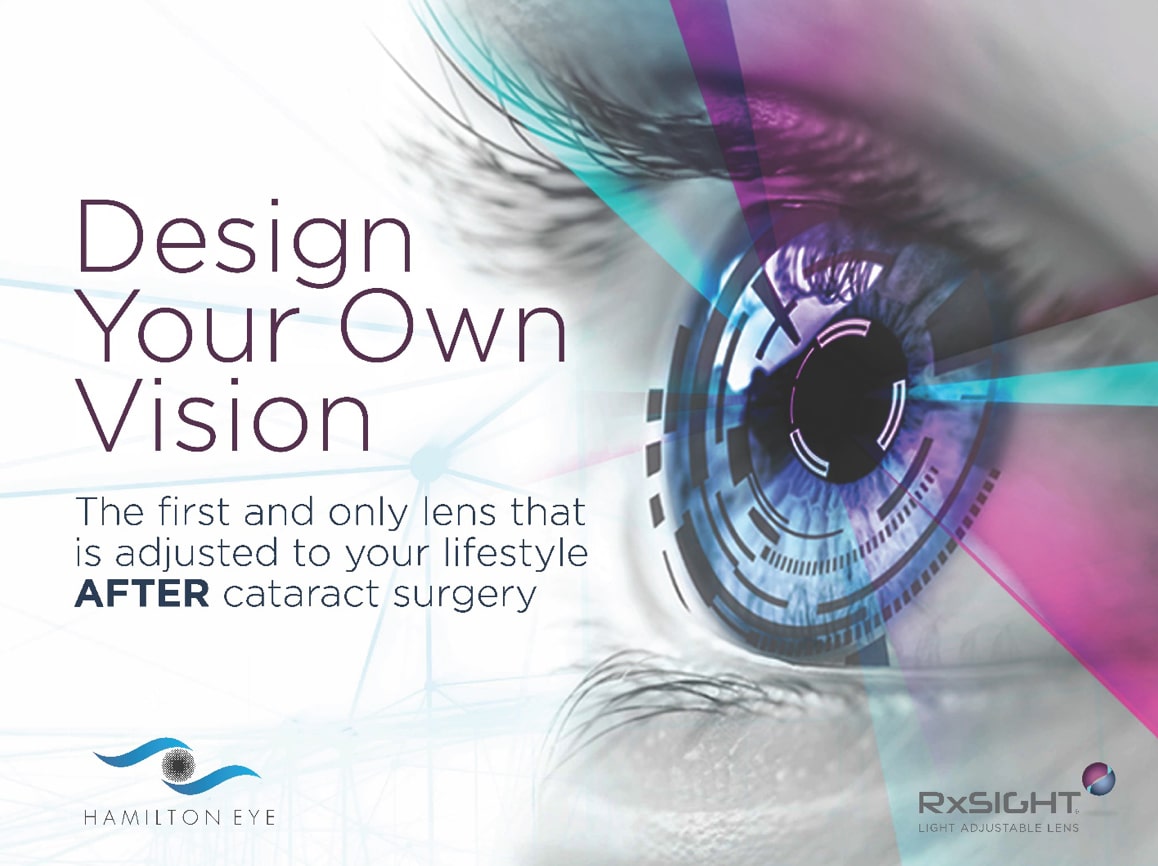
The Light Adjustable Lens (LAL) is the only IOL that enables you and Dr. Hamilton to design, trial, and customize your vision after cataract surgery. Adjustability takes cataract surgery to the next level by giving you a lens customized specifically for your eyes.
In an FDA study of 600 subjects, those who received the LAL were twice as likely (as those who received a standard monofocal IOL) to achieve 20/20 vision without glasses.
The Light Adjustable Lens is made of a special photo-sensitive material that changes the power of your implanted lens in response to UV light, increasing the likelihood that you will achieve your desired vision after cataract surgery.
If you select the Light Adjustable Lens, the first step is to have your cataract safely removed and the adjustable IOL implanted. The cataract removal and IOL implantation procedure are the same as if you selected a standard (non-adjustable) IOL.
Now for the unique part! After your eye heals, you return to your eye doctor to have your vision tested during a routine eye exam. Based on this exam, you and your eye doctor will select a custom prescription for your adjustable lens based on your own eyes and unique lifestyle requirements.
Light Treatments

To receive the light treatment, you will be placed in front of the Light Delivery Device, which will non-invasively deliver the UV light to your Light Adjustable Lens.
Between 2 and 4 total light treatments, each lasting approximately 90 seconds and separated by approximately 3 days are required. The total number of treatments is based on your satisfaction with the vision achieved. For the first time ever, you can have confidence that your result will be just how you want to see the world.
UV Light Sensitive Lenses after Cataract Surgery
The sun is the primary natural source of UV light, and artificial sources of UV light are safely used in many medical and ophthalmic treatments. However, as exposure to indoor and outdoor sources of UV light can cause uncontrolled changes to the Light Adjustable Lens– you will be provided with UV protective glasses to wear during all waking hours when outdoors (from time of lens implantation until after the last light treatment is completed).
24 hours after the final light treatment, no further changes can be made to the implanted LAL, and you can remove the UV protective glasses and enjoy your custom vision.
Light Treatment Schedule
A minimum of 2 light treatments—each lasting approximately 90 seconds and separated
by approximately 3 days—are required. The total number of light treatments is based on achievement of the desired vision outcome that you and your doctor selected.
Once you have achieved your final optimal vision, the lens power is permanently locked in with a final light treatment to prevent any further changes.
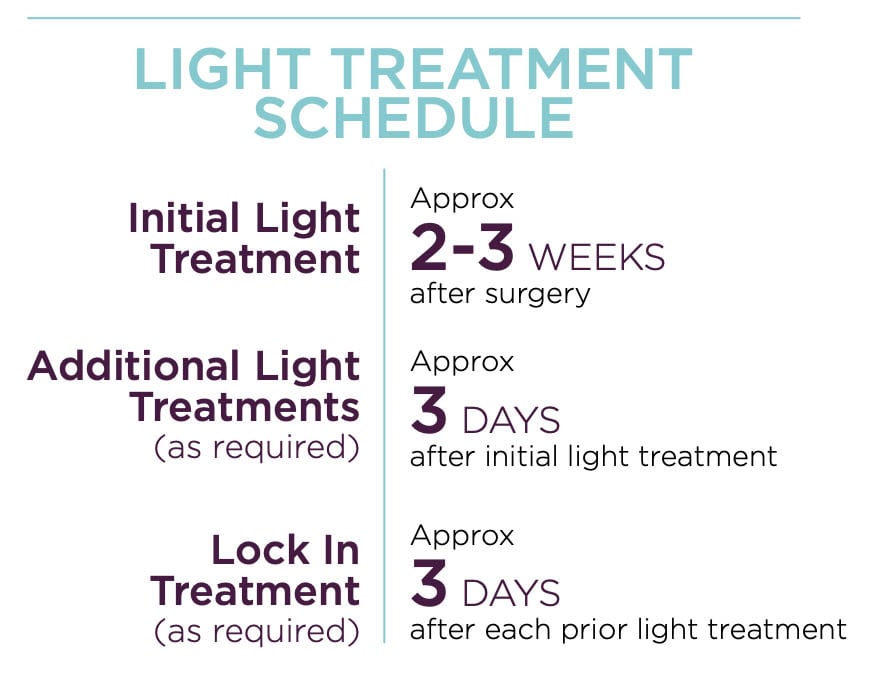
Who Can Benefit?
The U.S. Food and Drug Administration has approved the Light Adjustable Lens and Light Delivery Device for patients with pre-existing astigmatism of 0.75 diopters or more who are undergoing cataract surgery.
Other commercially available IOLs may be available for the treatment of your cataracts and your doctor will help you determine which lens is right for you.
Ask your doctor to explain the possible risks and benefits of cataract surgery. For risks and benefits specifically related to the RxSight Light Adjustable Lens, please see the next slide.
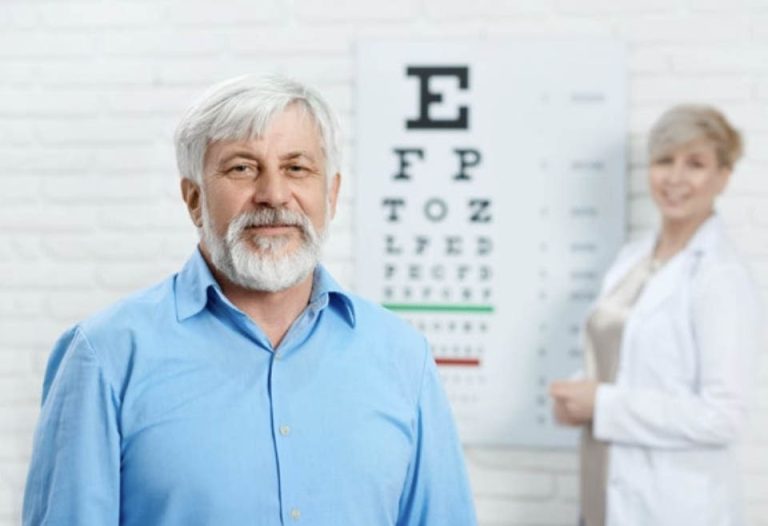
Approved use: The Light Adjustable Lens and Light Delivery Device (LDD) system is approved for patients who have a cataract and need surgery for it, have corneal astigmatism (at least 0.75 diopters) before surgery, and do not have preexisting macular disease.
Who should not receive this treatment? The Light Adjustable Lens and LDD system should not be used if you are taking medications that may increase your sensitivity to ultraviolet (UV) light; if you are taking a medication that is considered harmful to your retina; if you have a history of herpes eye infection or uncontrollable eye movements (nystagmus); or if you are unable to comply with your doctor’s schedule of LDD light treatments and instructions for wearing special UV-protective glasses for several weeks following cataract surgery.
What warnings should I be aware of? Preexisting macular disease and certain eye conditions may increase the risk of complications. Your doctor will determine if you are a good candidate for the Light Adjustable Lens. If you have any complications during your cataract surgery before the Light Adjustable Lens is implanted, you may need to have another intraocular lens (IOL) implanted instead of the Light Adjustable Lens.
What precautions should I be aware of? The safety and effectiveness of the Light Adjustable Lens and LDD have not been established in patients with certain preexisting eye conditions or in patients who experience certain complications during cataract surgery. You should discuss these issues with your doctor. Following surgery, you must wear the special UV-protective glasses during all waking hours for about 4 to 5 weeks and comply with your doctor’s schedule of LDD light treatments. Failure to wear the UV-protective glasses can result in an unpredicted vision change or loss of vision quality after exposure to UV light, such as from sunlight. This may require a second surgery to remove the Light Adjustable Lens from your eye and replace it with another IOL.
What are the potential risks? As with any surgical procedure, there are risks associated with cataract surgery and IOL implantation. Please discuss these risks with your doctor. Potential risks associated with LDD light treatments include mild alterations to color perceptions; temporary scratchiness, irritation, or dryness to the front part of your eye; and activation of a previously undiagnosed herpes eye infection. Longer lasting and serious adverse events related to the UV light exposure are possible, but rare. There is a small chance that your vision could be made worse or that you may require additional surgery as a result of a complication.
Caution: Federal law restricts this device to sale by or on the order of a physician.
Additional Information:
what should I expect after each light treatment?
Your vision may be blurry immediately after each treatment due to a gel used during application of the light treatment, but this should resolve quickly. Additionally, your eye may be dilated for the treatment, which may require wearing tinted glasses for a few hours. It may take approximately 24 hours after each light treatment to notice an improvement in your vision. The light from the LDD may also cause a temporary or long-lasting pink or red afterimage, which is common with a light source directed to the eye. This tinge to your vision is especially noticeable on things that normally look white.
Are the light treatments painful?
Numbing drops will be applied to your eye, and there may be some mild pressure or discomfort. However, the light treatments should not be painful.
How long do the light treatments last?
Each light treatment will last between 8 and 120 seconds, with the average being approximately 90 seconds. Variation in time is dependent on the type of treatment performed.
How many total light treatments would I need?
A minimum of two light treatments—each lasting approximately 90 seconds—are required. The total number of light treatments is based on achievement of the desired visual outcome that you and your doctor selected. Once you have achieved your final optimal vision, the lens power is permanently locked with a final light treatment to prevent any further changes.
What should I do if I forgot to wear my U-V blocking sunglasses?
It is very important that you do not forget to wear your UV-blocking glasses. However, if you do forget, please put them on as soon as you remember.
What happens if I lose or break my UV-blocking glasses?
Please notify your eye doctor/clinic as soon as possible if one of your two pairs of UV-blocking glasses are lost, damaged or unwearable, and then continue to wear the other pair. If both pairs are lost or damaged, wear the darkest sunglasses you have and contact your eye doctor/clinic.
Can I wear my regular sunglasses that have UV protection?
No. You must wear the UV-blocking glasses provided to you. These glasses have a special protective coating that no other glasses have.
I have a special event to attend in between light treatments, do I really have to wear the UV-blocking glasses?
Yes, you must wear them all waking hours to prevent uncontrolled changes to the Light Adjustable Lens. It is important to think about the time period over which you must wear the UV-blocking glasses and any commitments that you may have. It may be best to schedule your surgery and treatments around these commitments.
How long do I have to wear the UV-blocking glasses?
The UV-blocking glasses must be worn at all times until your eye doctor tells you that you no longer need to wear them (usually 24 hours after your final light treatment). Total wear is typically about 4 to 5 weeks in duration, however, this may vary depending on the number of light treatments delivered.
Why do I have to wear UV-blocking glasses?
The UV-blocking glasses provided to you protect the Light Adjustable Lens from UV light sources other than the LDD that your doctor will use to optimize your vision. Exposing the Light Adjustable Lens to other UV light sources will potentially change the lens correction in an uncontrolled manner. If you do not wear the provided UV-blocking glasses, your vision may not improve or it could get worse. If this happens, please contact your physician.
What should I expect in the period after cataract surgery?
Please follow all instructions provided to you by your eye doctor and staff, including wearing of the UV-blocking glasses that will be provided to you. As with any cataract surgery, your vision may not be perfect after surgery. While your eye doctor selected the lens he or she anticipated would give you the best possible vision, it was only an estimate. Fortunately, you have selected the Light Adjustable Lens! In the next weeks, you and your eye doctor will work together to optimize your vision. Please make sure to pay close attention to your vision and be prepared to discuss preferences with your eye doctor.
How does the Light Adjustable Lens™ work?
The unique feature of the Light Adjustable Lens is that the shape and focusing characteristics can be changed after implantation in the eye using an office-based UV light source called a Light Delivery Device or LDD. The Light Adjustable Lens itself has special particles (called macromers), which are distributed throughout the lens. When ultraviolet (UV) light from the LDD is directed to a specific area of the lens, the particles in the path of the light connect with other particles (forming polymers). The remaining unconnected particles then move to the exposed area. This movement causes a highly predictable change in the curvature of the lens. The new shape of the lens will match the prescription you selected during your eye exam.
Light Adjustable Lens Beverly Hills, Los Angeles, CA
[/fusion_text][/fusion_builder_column][/fusion_builder_row][/fusion_builder_container]

